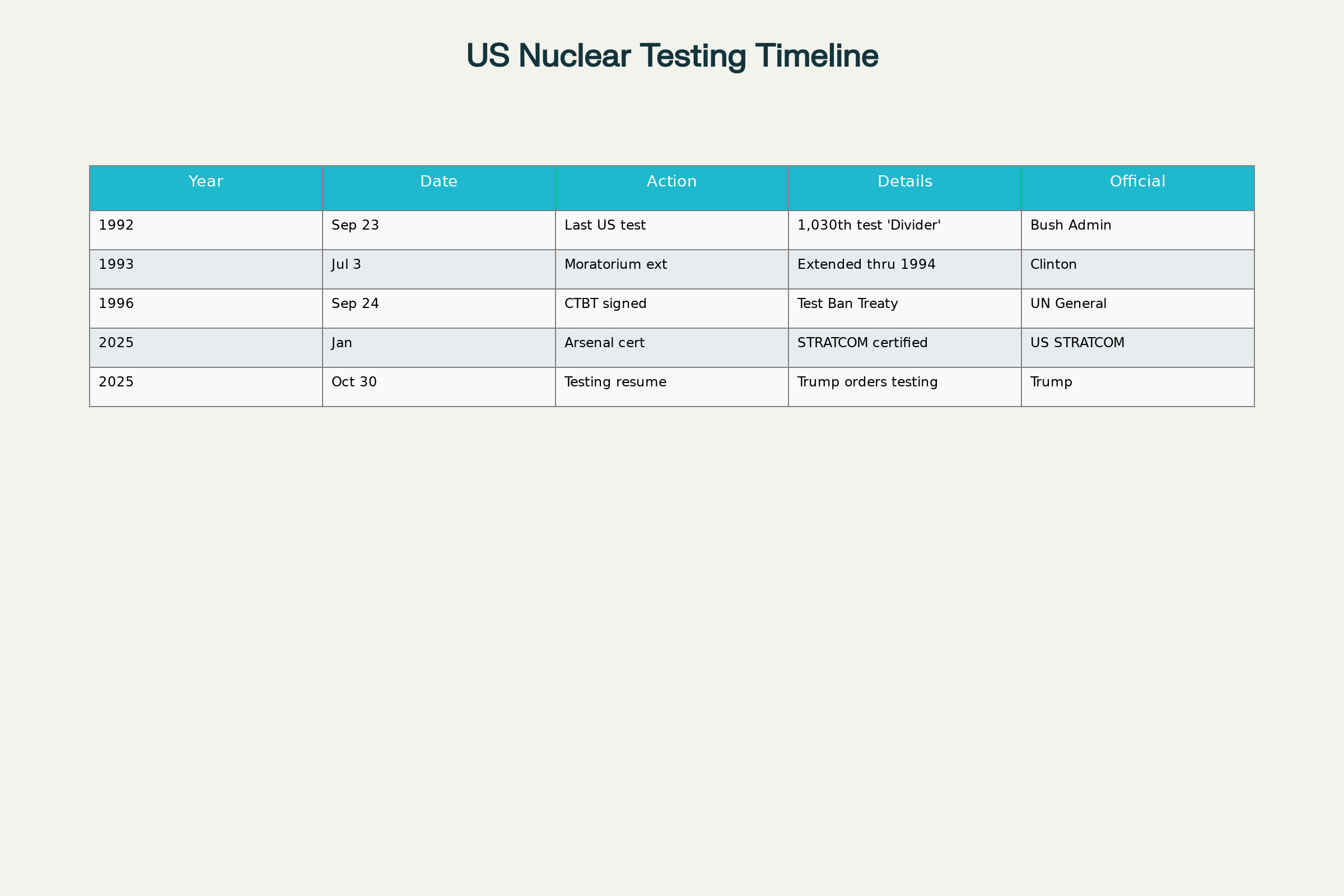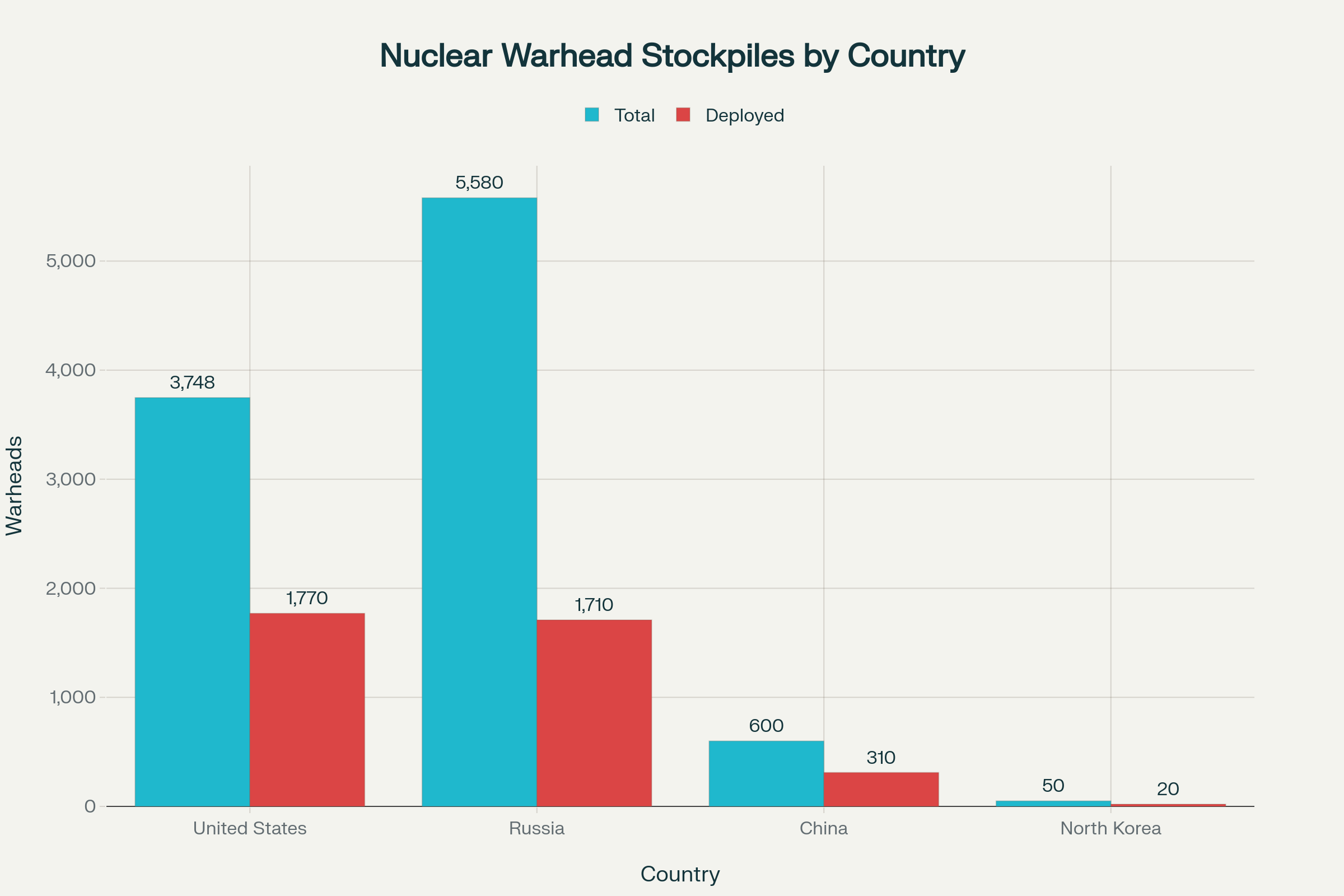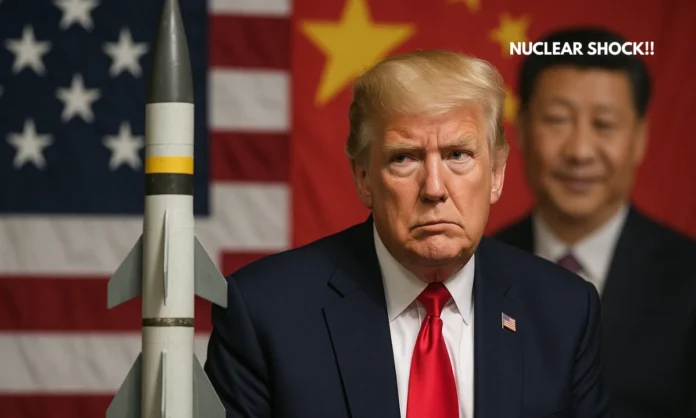Key Highlights:
- President Trump’s directive to resume nuclear weapons testing ends a 33-year moratorium maintained since 1992
- The announcement caught Pentagon officials and lawmakers off-guard during STRATCOM nominee confirmation hearings
- Vice President JD Vance defended the decision as necessary to ensure nuclear arsenal functionality against rival nations
President Donald Trump’s sudden announcement on October 30, 2025, directing the Pentagon to “immediately start testing Nuclear Weapons” has unleashed a wave of confusion and alarm across Washington’s national security establishment. The directive, issued via Truth Social just hours before Trump’s meeting with Chinese President Xi Jinping in South Korea, represents the most dramatic shift in US nuclear policy in over three decades and has created unprecedented uncertainty about America’s strategic deterrence approach.
Trump’s comments on nuclear testing sparked fears and confusion throughout the US government, with officials scrambling to understand whether the president intended explosive warhead testing or delivery system evaluations. The timing of the announcement, delivered at 9:04 pm the night before Vice Admiral Richard Correll’s confirmation hearing to lead Strategic Command, created an unprecedented scenario where the nominee faced extensive questioning about a policy shift he had no prior knowledge of, demonstrating how Trump’s comments on nuclear testing caught even senior military leadership completely unprepared.
🔥 COMMAND DIRECTIVE FROM THE TOP – TRUMP ACTIVATES NUCLEAR DOCTRINE 2.0: “I HATED TO DO IT, BUT HAD NO CHOICE”. The Era of Strategic Weakness Is Over. America Goes Nuclear.
— Medeea Greere (@GreereMedeea) October 30, 2025
🚨 Trump orders immediate testing of U.S. nuclear weapons, declaring “no choice” as China and Russia… pic.twitter.com/4DDeOHPpEr
Pentagon Officials Caught Unprepared by Policy Reversal
The Trump administration’s nuclear testing directive exposed significant gaps in inter-agency communication and policy coordination within the Defense Department. Vice Admiral Richard Correll, Trump’s nominee to head US Strategic Command, testified before the Senate Armed Services Committee that he had no insight into the president’s intent regarding the testing announcement, illustrating how Trump’s comments on nuclear testing bypassed normal military consultation channels.
During his confirmation hearing, Correll faced repeated questioning from senators seeking clarification on whether Trump meant explosive nuclear testing or missile delivery system testing. Senator Angus King pressed Correll on the distinction, asking whether the announcement could refer to testing delivery systems rather than nuclear devices themselves. The nominee responded cautiously, stating he wouldn’t presume to know the president’s intent and noted that neither China nor Russia had conducted nuclear explosive tests recently, suggesting that Trump’s comments on nuclear testing might refer to conventional weapons system evaluations rather than warhead detonations.
Pentagon officials did not immediately respond to requests for comment about Trump’s announcement, highlighting the apparent lack of advance coordination on the policy shift. The confusion extended to senior military leadership, with STRATCOM having just certified the US nuclear arsenal as safe and reliable in January 2025, making the timing of the testing directive particularly puzzling to defense experts who questioned why Trump’s comments on nuclear testing were necessary given existing stockpile assessments.
Senator Jack Reed, the top Democrat on the Armed Services Committee, questioned whether resuming nuclear explosive testing would destabilize international relations and trigger a global arms race. The hearing underscored how Trump’s comments on nuclear testing created immediate concerns among lawmakers about potential escalation with nuclear rivals and the abandonment of decades-old nonproliferation commitments that have maintained global nuclear stability.
International Reactions Heighten Global Nuclear Tensions
Russia’s response to Trump’s nuclear testing announcement demonstrated how the president’s directive immediately escalated international tensions and raised the specter of a new arms race. Kremlin spokesperson Dmitry Peskov reiterated President Vladimir Putin’s previous warning that Moscow would resume nuclear testing if any other nation broke the moratorium first, showing how Trump’s comments on nuclear testing could trigger reciprocal actions from major nuclear powers.
Iran’s Foreign Minister Abbas Araghchi strongly condemned the US decision, calling it “backward” and “irresponsible” while highlighting the contradiction between America’s nuclear testing plans and its criticism of Iran’s peaceful nuclear program. Araghchi’s statement on X emphasized how Trump’s comments on nuclear testing created immediate diplomatic tensions with regional powers who view the announcement as American nuclear aggression and hypocrisy regarding nonproliferation standards.
China’s foreign ministry expressed hope that the United States would honor its commitment to the nuclear testing moratorium and obligations under the Comprehensive Test Ban Treaty. Beijing’s response reflected broader international concern that Trump’s comments on nuclear testing could unravel decades of nuclear restraint agreements that have prevented a global arms race and maintained relative strategic stability among major powers.
North Korea, as the only nation to conduct nuclear tests in this century with its last explosion in 2017, represents a key factor in Trump’s justification for resuming testing. The president’s social media post specifically referenced the need to test “on an equal basis” with other countries, suggesting his decision was partly motivated by Pyongyang’s continued nuclear development, though experts questioned whether Trump’s comments on nuclear testing would effectively deter North Korean nuclear ambitions or simply provide justification for expanded testing programs.

Timeline of US Nuclear Testing Policy: From Moratorium to Resumption Plans (1992-2025)
Technical and Logistical Challenges of Resuming Nuclear Tests
The Nevada National Security Site, spanning 1,350 square miles in the Nevada desert, stands ready to conduct nuclear tests within the federally mandated 36-month preparation period. The facility, formerly known as the Nevada Test Site, hosted 928 nuclear tests between 1951 and 1992 before the US moratorium took effect, though reactivating the site would require substantial resources and time to ensure proper implementation of Trump’s comments on nuclear testing into actual operational capacity.
Nevada Democratic lawmakers immediately mobilized opposition to Trump’s testing plans, citing both safety concerns and the unnecessary nature of explosive nuclear testing given current stockpile certification methods. Senator Jacky Rosen stated during the confirmation hearing that she would fight to prevent nuclear testing in her home state, emphasizing Nevada’s historical suffering from radioactive fallout between 1951 and 1992, and arguing that Trump’s comments on nuclear testing ignored the environmental and health consequences of resumed explosive testing programs.
The technical infrastructure at the Nevada site includes 1,100 buildings across 28 areas connected by 400 miles of paved roads and 300 miles of unpaved roads, demonstrating the massive logistical undertaking required for nuclear testing operations. However, experts note that restarting explosive testing would require significant time and resources to ensure proper safety protocols and environmental monitoring systems, raising questions about the feasibility of implementing Trump’s comments on nuclear testing within his stated immediate timeline.
Representative Dina Titus announced plans to introduce the RESTRAIN Act to ban explosive nuclear tests in the United States, reflecting growing congressional opposition to Trump’s directive. The proposed legislation highlights how Trump’s comments on nuclear testing sparked immediate political backlash and legislative countermeasures designed to prevent the resumption of explosive nuclear testing regardless of presidential directives or international competitive pressures.
Strategic Implications for US Nuclear Deterrence Policy
The resumption of nuclear testing could fundamentally alter America’s strategic deterrence calculations and relationships with both allies and adversaries. Experts argue that breaking the 33-year moratorium would benefit US rivals by allowing them to conduct their own tests and gather valuable nuclear weapons development data, suggesting that Trump’s comments on nuclear testing could backfire by providing adversaries with justification for expanded nuclear programs rather than enhancing American security.
Tara Drozdenko, director of the global security program at Union of Concerned Scientists, emphasized that there is no good reason for the United States to resume explosive nuclear testing, warning it would make Americans less safe. The Ploughshares Foundation noted that the United States already possesses extensive data from its 1,030 nuclear tests conducted since 1945, giving it significant advantages over potential adversaries and raising questions about the strategic logic behind Trump’s comments on nuclear testing when simulation methods provide adequate reliability assessments.
James Acton from the Carnegie Endowment for International Peace questioned whether Trump’s testing directive would successfully pressure China into nuclear arms negotiations, suggesting the strategy was unlikely to achieve its intended diplomatic objectives. China has consistently rejected US efforts to engage in trilateral nuclear talks with Russia, arguing that American and Russian arsenals remain significantly larger than Beijing’s capabilities, indicating that Trump’s comments on nuclear testing may not produce the negotiating leverage the administration seeks.
The current US nuclear stockpile contains 3,748 warheads as of September 2023, representing an 88% reduction from its peak of 31,255 warheads in 1967. This substantial arsenal reduction underscores expert arguments that Trump’s comments on nuclear testing address a non-existent problem given America’s existing nuclear superiority and the effectiveness of computer simulation methods for maintaining warhead reliability without the risks and costs associated with explosive testing programs.

Global Nuclear Stockpiles and Testing Status by Major Powers (2024-2025)
Closing Assessment of Policy Ramifications
Trump’s directive to resume nuclear weapons testing after more than three decades represents a watershed moment that could reshape global nuclear dynamics and America’s role in international arms control efforts. The president’s announcement has created unprecedented uncertainty within the defense establishment while simultaneously alarming international partners who have relied on US leadership in nuclear nonproliferation, demonstrating how Trump’s comments on nuclear testing have immediate consequences beyond American borders.
The immediate political and diplomatic fallout from the announcement demonstrates the far-reaching consequences of abandoning long-standing nuclear restraint policies. As congressional opposition mounts and international partners express concern, the administration faces the challenge of implementing a policy that contradicts decades of bipartisan nuclear security doctrine, with lawmakers and experts questioning whether Trump’s comments on nuclear testing serve any legitimate security purpose or simply create unnecessary international tensions.
Whether Trump’s nuclear testing announcement represents a serious policy shift or a negotiating tactic remains unclear, but its impact on global nuclear stability and US credibility in arms control forums will likely persist long after the immediate controversy subsides. The episode highlights how presidential communications on nuclear matters require careful coordination and consideration of their broader strategic implications, particularly when Trump’s comments on nuclear testing have the potential to trigger reciprocal actions from nuclear rivals and undermine decades of nonproliferation progress.


